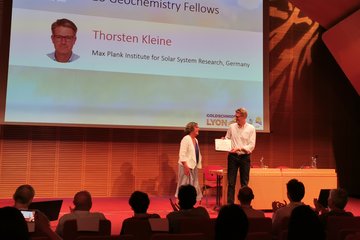Alle Typen
121.
Zeitschriftenartikel
Turbulent boundary layer at the border of geomagnetic trap. JETP Letters 74 (11), S. 620 - 624 (2001)
122.
Zeitschriftenartikel
Turbulent Boundary Layer at the Border of Geomagnetic Trap. JETP Lett. 74, S. 547 (2001)
123.
Zeitschriftenartikel
Multi-instrument study of the upstream region near Mars: Phobos-2 observations. Journal Geophysical Research 105, S. 7557 - 7571 (2000)
124.
Zeitschriftenartikel
Deceleration of the solar wind upstream of the Martian bow schock. Mass-loading or foreshock features? Advances in Space Research 26, S. 1627 - 1631 (2000)
125.
Zeitschriftenartikel
Plasma characteristics of high-altitude cusp for steady southward-dawnward. Advances in Space Research 25, S. 1435 - 1444 (2000)
126.
Zeitschriftenartikel
Characteristics of the exterior cusp for steady southward interplanetary magnetic field: Interball observations. Journal Geophysical Research 105, S. 15945 (2000)
127.
Zeitschriftenartikel
The nature of the martian 'obstacle boundary'. Advances in Space Research 26, S. 1633 - 1637 (2000)
128.
Zeitschriftenartikel
Physics of mass loaded plasmas. Space Science Reviews 94, S. 429 - 671 (2000)
129.
Zeitschriftenartikel
The Martian magnetosphere - a laboratory for bi-ion plasma investigations. Astrophysics and Space Science 264, S. 273 - 288 (1999)
130.
Zeitschriftenartikel
The IMF control of the Martian bow shock and plasma flow in the magnetosheath. Predictions of 3D simulations and observations. Earth, Planets and Space 50, S. 873 - 882 (1999)
131.
Zeitschriftenartikel
The IMF control of the Martian bow shock and plasma flow in the magnetosheath. Predictions of 3D simulations and observations. Earth, Moon and Planets 50, S. 873 - 882 (1999)
132.
Zeitschriftenartikel
Cometosheath structures and tail rays: Outcome of bi-ion fluid simulations. Earth, Moon and Planets 77, S. 271 - 278 (1999)
133.
Zeitschriftenartikel
Proton cyclotron emission at the AMPTE Ba release. Advances in Space Research 24, S. 85 - 89 (1999)
134.
Zeitschriftenartikel
Electromagnetic waves near and below the proton cyclotron frequency at the AMPTE Ba release relevance to comets and Mars. Journal Geophysical Research 104, S. 6763 - 6771 (1999)
135.
Zeitschriftenartikel
Phobos events - signatures of solar wind interaction with a gas torus? Earth, Planets and Space 50, S. 453 - 462 (1998)
136.
Zeitschriftenartikel
Upstream magnetic field disturbances near Mars. Journal Geophysical Research 103, S. 317 - 326 (1998)
137.
Zeitschriftenartikel
Multiple shocks near Mars. Earth, Planets and Space 50, S. 279 - 288 (1998)
138.
Zeitschriftenartikel
The IMF bending upstream of the Martian bow shock. Earth, Planets and Space 50, S. 295 - 302 (1998)
139.
Zeitschriftenartikel
The IMF control of the Martian bow shock and plasma flow in the magnetosheath. Predictions of 3D simulations and observations. Earth, Planets and Space 50, S. 873 - 882 (1998)
140.
Zeitschriftenartikel
Model calculations of the planetary ion distribution in the Martian tail. Earth, Planets and Space 50, S. 445 - 452 (1998)











